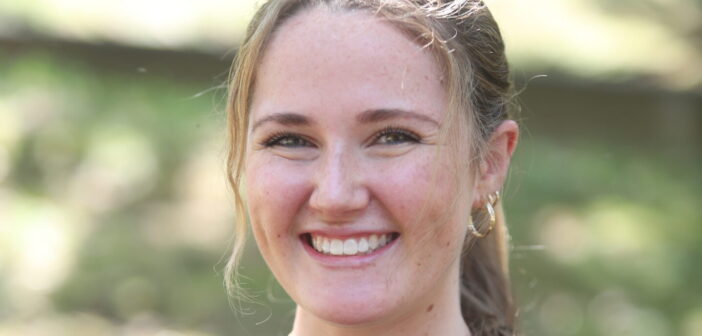In an homage to ‘70s music, “Daisy Jones and The Six” follows a rock band and the drama of life on the road in the limelight.
Taylor Jenkins Reid strings together a series of fictional interviews led by an anonymous inquirer. Though an earlier novel by Reid, “The Seven Husbands of Evelyn Hugo,” is told in interview style as well – from the perspective of a journalist interviewing a famous film star – “Daisy Jones and The Six” enters an entirely new realm of storytelling.
As the band members and other interviewees discuss their pasts, Reid weaves their responses into a cohesive story – made scandalous when the characters recount specific events entirely differently.
Through these “interviews,” Reid pushes past the facade of sex, drugs and music to explore neglect, forbidden love and betrayal.
The story begins in two separate worlds – that of the Dunne Brothers and that of young Daisy Jones.
In their hometown of Pittsburgh, The Dunne Brothers, comprised of lead singer Billy Dunne, guitarists Graham Dunne, Eddie Roundtree, drummer Warren Rhodes and bassist Pete Loving, play low-key gigs at weddings and birthday parties, hoping to be discovered. They become The Six with the addition of keyboardist Karen Sirko following an impulsive move to California.
Daisy, the product of wealthy parents who never saw her as anything but a pretty face they could show off to their friends, feels neglected, lonely and misunderstood.
As the Dunne Brothers struggle to make a name for themselves, Daisy has no trouble making the wrong one. She follows her love of music from club to club and her desperation for attention from bed to bed.
Daisy’s morning mixture of a benny (a tablet of Benzedrine), a cup of coffee and a glass of champagne serves as the perfect metaphor for her life: the up and down.
Though Daisy and The Six separately record albums that garner minor attention with producer Teddy Price, it isn’t enough for anyone. The Six always wanted to be “the biggest band in the world,” and Price knows in order to do so, they need to make a big change. Hoping to give the desperate artists a true chance at success, Teddy pairs wild card Daisy with a newly rehabilitated Billy and the rest of The Six.
When the two worlds collide, something extraordinary yet dangerous is born. Daisy tempts Billy with everything he has made vows to quit, and Billy breaks the barrier of Daisy’s carefree exterior.
At first glance, the two are polar opposites. Daisy is a free-spirited, enigmatic singer with a magnetic presence and a reputation for partying, while Billy is a serious and dedicated frontman with a deep devotion to his wife, Camila, and their daughter. But,there is an undeniable chemistry between the two rock stars.
On stage, Reid’s descriptions of Billy and Daisy sharing a microphone and staring into each other’s eyes are compelling and oddly beautiful. But, I can feel the hate between the two just as profoundly in the many recounted moments of them screaming at each other, throwing things and storming off.
Loosely based on the tortured romance of rock legends Stevie Nick and Lindsey Buckingham, the love/hate relationship between Daisy and Billy is nothing short of dramatic and intense.
Daisy’s character is intriguing but immensely frustrating. I find it difficult to feel bad for her when it seems she is standing in her own way. Time and time again she carelessly throws away opportunities, seemingly disregarding those she hurts in the process. That being said, she also adds a lot of depth to the story, as she struggles with family issues and her mental health while simultaneous providing the band with fresh ideas and a willingness to stand up to Billy no one’s had before.
Camila, Billy’s wife, and Simone, Daisy’s best friend, are both great additions to the story, as they limit the harm Billy and Daisy, respectively, do to themselves as much as they can. Their fierce allegiance, unimaginable patience and steadfast love are admirable.
Camila’s impact is far more profound than I initially realized. Though it seems the world revolves around Billy and Daisy, the only reason the duo keeps working together and become so successful is due to Camila’s forgiveness and faith. For Billy and the rest of the band, Camila offers a sense of normalcy and groundedness, a sharp contrast to the life they live and the temptations they face on the road.
Though I initially questioned Billy’s character, he grew on me as he put his family first and resisted the ever-present urge to reach for a drink, a pill or Daisy. As Camila forgives Billy’s indiscretions and Daisy pushes him to write about the truth, I see a remarkable change in his character. He overcomes his unrealistic expectations for the future, instead appreciating that “loving somebody isn’t perfection and good times and laughing and making love. Love is forgiveness and patience and faith and every once in a while, it’s a gut punch.”
Reid’s inclusion of the other band members’ stories and dramas created a welcome shift of perspectives throughout the story.
Pete is a harmless character, not adding too much to the dynamic, but also never taking anything away. Conversely, I honestly saw Eddie as an annoyance when he voiced his opinions, whether or not he was in the right.
The fun-loving drummer Warren serves often as comedic relief and maintains his positive attitude throughout the story. He is described as “the backbone of The Six,” but though I loved his character, I found that Karen serves as the backbone of the band.
Karen is level-headed, knows when to put her foot down and is loyal above all else. I appreciate her refusal to conform to a male-dominated industry, as she makes a point of wearing clothing that doesn’t draw attention to her body in an effort to draw more attention to her music.
Karen’s persona coupled with Daisy’s position as a leader and role model to young girls during this time highlight the real-world issue of gender inequality and the influence the ‘70s had on female empowerment.
I also really enjoyed Graham’s character, the reserved and mysterious younger brother of Billy, who grapples with unrequited love and devotion, though there were times when I wished he would stand up for himself more.
The other side characters, like Price and Rolling Stone reporter Jonah Berg, also play a crucial role in developing the complex relationship between Billy and Daisy and the chaos that is life in or involved with a rock and roll band.
The inspiration Reid draws from ‘70s musicians, namely Fleetwood Mac, is palpable throughout the novel. Just as Fleetwood Mac fused folk and rock together during their rise to fame, Daisy Jones and the Six insert elements of pop music and transition from hard rock to a softer alternative.
Alluding again to musical evolution in the ‘70s, Reid puts emphasis on Billy and Daisy’s songwriting processes. Just as Fleetwood Mac was notable for the emotionally charged, raw and honest lyrics of ‘Rumours,’, Daisy Jones and the Six finally make it to No. 1 with ‘Honeycomb,” a song Billy orginally wrote about redemption that Daisy alters to be about doubt and broken promises.
The television series based on this book does not do any of the characters justice, save for making Eddie just as irritating as he is in the book, and I find it hard to watch after reading such a superior version of the story.
It truly felt as if I was reading the oral history of real people about their real lives, as Reid eloquently weaves emotions and disposition into each character’s dialogue. This made for nothing short of a refreshing and compelling read, and I rate this book 4.5/5 stars.






Comment policy
Comments posted to The Brown and White website are reviewed by a moderator before being approved. Incendiary speech or harassing language, including comments targeted at individuals, may be deemed unacceptable and not published. Spam and other soliciting will also be declined.
The Brown and White also reserves the right to not publish entirely anonymous comments.